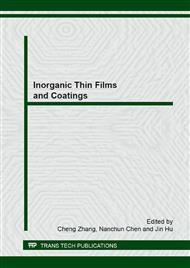[1]
J. Meier, R. Flückiger, H. Keppner, and A. Shah, Complete microcrystalline pin solar cell - Crystalline or amorphous cell behavior, Appl. Phys. Lett. 65 (1994) 860-862.
DOI: 10.1063/1.112183
Google Scholar
[2]
A.V. Shah, J. Meier, E. Vallat-Sauvain, N. Wyrsch, U. Kroll, C. Droz, U. Graf,Material and solar cell research in microcrystalline silicon, Sol. Energy Mater. Sol. Cells 78 (2003) 469–491
DOI: 10.1016/s0927-0248(02)00448-8
Google Scholar
[3]
R. H. Franken, R. L. Stolk, H. Li, et al., Understanding light trapping by light scattering textured back electrodes in thin film n-i-p-type silicon solar cells, J. Appl. Phys. 102(2007)014503.
DOI: 10.1063/1.2751117
Google Scholar
[4]
J. Meier, S. Dubail, S. Golay, et al., Microcrystalline silicon and the impact on micromorph tandem solar cells Sol. Energy Mater. Sol. Cells 74 (2002) 457-467
DOI: 10.1016/s0927-0248(02)00111-3
Google Scholar
[5]
J. Bailat, D. Dominé, R. Schlüchter, et al., High-efficiency P-I-N microcrystalline and micromorph thin film silicon solar cells deposited on LPCVD ZnO coated glass substrates, IEEE 4 WCPEC (2006)1533.
DOI: 10.1109/wcpec.2006.279775
Google Scholar
[6]
Y. Nasuno, M. Kondo, A. Matsuda, Microcrystalline silicon thin-film solar cells prepared at low temperature using PECVD, Sol. Energy Mater. Sol. Cells 74 (2002) 497-503.
DOI: 10.1016/s0927-0248(02)00065-x
Google Scholar
[7]
J. Bailat, E. Vallat-Sauvain, L. Feitknecht, et al., Influence of substrate on the microstructure of microcrystalline silicon layers and cells, J. Non-Crystalline Solids 299–302 (2002) 1219-1223
DOI: 10.1016/s0022-3093(01)01142-5
Google Scholar
[8]
E. Vallat-Sauvain, J. Bailat, J. Meier, et al., Influence of the substrate's surface morphology and chemical nature on the nucleation and growth of microcrystalline silicon, Thin Solid Films 485 (2005) 77-81
DOI: 10.1016/j.tsf.2005.03.017
Google Scholar
[9]
M. Python, E. V.Sauvain , J. Bailat, D. Domine´, L. Fesquet, A Shah, C. Ballif,Relation between substrate surface morphology, J.Non-Cryst. Solids 354 (2008) 2258–2262
DOI: 10.1016/j.jnoncrysol.2007.09.084
Google Scholar
[10]
B.T. Li, R.H. Franken, J.K. Rath, etal., Structural defects caused by a rough substrate and their influence on the performance of hydrogenated nano-crystalline silicon n–i–p solar cells, Sol. Energy Mater. Sol. Cells, 93 (2009) 338-349
DOI: 10.1016/j.solmat.2008.11.013
Google Scholar
[11]
T. Söderström, F.J. Haug, V. Terrazzoni-Daudrix, et al., N/I buffer layer for substrate microcrystalline thin film silicon solar cell, J. Appl. Phys.104 (2008)104505
DOI: 10.1063/1.3021053
Google Scholar
[12]
H. Ihara and H. Nozaki, Improvement of Hydrogenated amorphous silicon n-i-p diode performance by H2 plasma treatment for i/p interface, Jpn. J. Appl. Phys 29 (1990) L2159
DOI: 10.1143/jjap.29.l2159
Google Scholar
[13]
J.H. Zhou, K. Ikuta, T. Yasuda, et al., Growth of amorphous-layer-free microcrystalline silicon on insulating glass substrates by plasma-enhanced chemical vapor deposition, Appl. Phys. Lett. 71(1997) 1534
DOI: 10.1063/1.119958
Google Scholar
[14]
J. Chantana, Y. Tsutsui, Y. Sobajima, et al., Importance of Starting Procedure for Film Growth in Substrate-Type Microcrystalline-Silicon Solar Cells, Jpn. J. Appl. Phys.50 (2011) 045806
DOI: 10.1143/jjap.50.045806
Google Scholar
[15]
F. Köhler, S. Schicho, B. Wolfrum, et al., Gradient etching of silicon-based thin films for depth- resolved measurements: The example of Raman crystallinity, Thin Solid Films 520 (2012) 2605–2608
DOI: 10.1016/j.tsf.2011.11.029
Google Scholar
[16]
Y. Ashida, M. Koyama, K. Miyachi, et al., Properties and stability of a-Si:H films by alternately repeating deposition and hydrogen plasma treatment, IEEE 22(1991)1352
DOI: 10.1109/pvsc.1991.169428
Google Scholar
[17]
S. Ishihara, D. He, and I. Shimizu, Structure of Polycrystalline silicon thin film fabricated from Fluorinated precursors by layer –by-Layer technique, Jpn. J. Appl. Phys., Part 1, 33 (1994)513.
DOI: 10.1143/jjap.33.51
Google Scholar
[18]
N. Layadi, P. Roca i Cabarrocas, and B. Drevillon, Reai-time spectroscopic ellipsometry study of the growth of amorphous and microcrystalline silicon thin films prepared by alternating silicon deposition and hydrogen plasma treatment, Phys. Rev. B 52 (1995) 5136
DOI: 10.1103/physrevb.52.5136
Google Scholar
[19]
T. Toyama , H. Okamoto,Structural and electrical studies of plasma-deposited polycrystalline silicon thin-films for photovoltaic application, Solar Energy 80(2006).658–666
DOI: 10.1016/j.solener.2005.12.007
Google Scholar
[20]
H. Tanaka, N. Ishiguro, T. Miyashita, et al., Improvement of p-I buffer layer properties by hydrongen plasma treatment and its applications to pin a-Si:H solar cells", Proc. 23th IEEE PVSC (1993) 811
Google Scholar
[21]
K. Saitoh, M. Kondo, M. Fukawa, et al., Role of the hydrogen plasma treatment in layer-by-layer deposition of microcrystalline silicon, Appl. Phys. Lett. 71(1997) 3403-3405
DOI: 10.1063/1.120324
Google Scholar
[22]
S. Sriraman, S.Agarwal, E. S. Aydil,D Maroudas, Mechanism of hydrogen-induced crystallization of amorphous silicon,Nature 418(2002) .62-65
DOI: 10.1038/nature00866
Google Scholar
[23]
I. Kaiser, N. H. Nickel, and W. Fuhs,Hydrogen-mediated structural changes of amorphous and microcrystalline silicon, Phys. Rev. B 58(1998)R1718-1721
DOI: 10.1103/physrevb.58.r1718
Google Scholar



